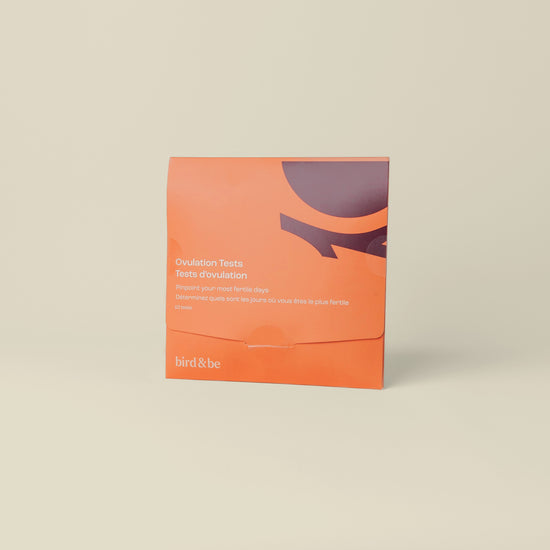If you’re trying to get pregnant, knowing when you ovulate—the once-per-cycle event when the egg is released—is key. Otherwise, you leave the meet-up between egg and sperm to chance. For a more strategic approach, at-home ovulation tests, also called ovulation predictor kits (OPK) or LH test, kits can help you nail down your fertile window for optimal timing.
These tests look for a surge in your luteinizing hormone (LH) levels, which is what tells your body that it’s time to ovulate. Typically, the egg will be released about 12 to 36 hours after your LH hits its high, and if it’s not fertilized within 24 hours of ovulation, it will dissolve. That’s a narrow window, but fortunately, sperm can live in the fallopian tubes for a few days, so it’s ideal to have them ready and waiting for the egg’s arrival. If you’re trying to conceive, it’s ideal to have sex/inseminate daily or every other day, starting about two days before you ovulate and until the day after. And while there are physical signs of ovulation you can look out for, ovulation tests can help you confidently pinpoint when ovulation is about to go down.
How to take an ovulation test
To make sure you don’t miss your LH surge, it’s a good idea to test daily for about five days, starting 16 days before your predicted period starts (this is based on the fact that ovulation typically happens two weeks before bleeding starts, so starting a couple days early will make sure you don’t miss it). For a 28-day cycle, you’d start testing on day 12 (try our easy tool to help you figure out when to take an ovulation test). LH is typically released in the morning so it’s ideal if you test in the morning or early afternoon. Here are the general steps for taking and using LH test strips:
- Pee into a clean, dry container. (Customers love our reusable, collapsible collection cup, which can be added to your test order.)
- Remove the test strip from any packaging and dip the white tip into the urine. Make sure not to go over the MAX marker line. Hold it there for five seconds.
- Remove the strip and lay it flat on a clean, dry, non-absorbent surface for five minutes. (We like to place the strip across the mouth of the urine container and set a timer.)
- Check your results at the five-minute mark (don’t go past this, as results may no longer be accurate).
How to read ovulation-test results
To read an ovulation test, you’ll need to compare the control line to the test line. The control line is the one that’s higher on the white end of the strip that you dipped in urine. It should turn dark to indicate that the test worked properly.
Positive ovulation test
A positive ovulation strip—indicating your LH surge—will have a test line (the bottom one) that’s as dark or darker than the control line.
Negative ovulation test

If the test line is lighter or MIA, it indicates that there’s no LH surge.
Tracking ovulation over five days

It’s recommended that you test for five consecutive days (or until you get a positive), ideally at the same time each day. Taking a daily photo of your strip can be a good way to compare the day-to-day progress.
For more information on how to read your results (including scenarios that don’t look like the five-day pattern above), check out our ovulation testing guide.
Shop Bird&Be Ovulation Tests →
What if I don’t see a dark test line in those five days?
Two things can be happening here. First, it’s possible that you’ve missed the surge. You could have ovulated earlier or later than the days you were testing. In this case, you’ll want to adjust when you start testing for the next cycle. Note when your period ends up coming, as it’s generally safe to assume you ovulated roughly 14 days before. You can use this timing to figure out when to start testing next cycle so you don’t miss your LH surge.
If based on your period timing it seems like you should have picked up your LH surge on the days you were testing, you may want to test more frequently in the next cycle. Sometimes the LH surge can happen really quickly, peaking and coming back down again between tests. You may want to try testing two or even three times a day to make sure you’re not missing a quick peak.
The other possibility is that you’re not getting a surge. If you’re having regular cycles, no need to stress. It could be that your LH peak is below the detectable baseline. Though that makes timing harder, it wouldn’t affect your ability to get pregnant. But if your LH isn’t surging and you have irregular cycles or are used to missing a period, this could mean you’re not ovulating and should talk to your doctor as soon as possible.
What if I see a faint line but not a dark one?
Faint lines mean that the test is picking up some LH, but not the same high amounts found during a surge. By comparing your ovulation test strip results day by day, you might be able to pick out days that occur closest to a surge. You can adjust your testing times, testing two or three times a day to see if you have a quick surge that is otherwise being missed by only testing once a day.
It’s also recommended to limit your fluid intake for about two hours before you test to avoid diluting the LH in your urine. If you still can’t seem to find any surge and don’t have regular cycles, it’s time to talk to your doctor to find out if you are indeed ovulating or not.
What if I have multiple days of dark lines?
If you have several days in a row of dark lines, or if you’re noticing more than one peak, time intercourse with the first high-LH day. If your cycles are regular and you get a period (or a positive pregnancy result!) about 14 days after your LH peak days, there’s no need to worry about multiple or plateaued peaks. If you’re regularly missing periods, speak to your doctor to find out if you’re ovulating.
Once you identify your peak LH day, you can estimate ovulation happening within about 12 to 36 hours and can time intercourse/insemination accordingly. Read more about how often to have sex or inseminate during your fertile window when trying to get pregnant.
What if I have a positive LH surge, and we’re having sex/inseminating in my fertile window but I’m not getting pregnant?
Many factors can affect your ability to become pregnant. Ovulation means that an egg is released, but fertilization of that egg and implantation of an embryo rely on the health and quality of the egg, sperm and uterine lining.
If you’ve been trying to conceive via intercourse or at-home insemination for more than 12 months and are 35 years old or younger, or if you’ve been trying for more than six months and are over 35, it’s time to talk to your doctor. And remember that there’s no need to wait if your cycles are irregular; you’ve had recurrent miscarriages; have a diagnosis such as endometriosis, PCOS or another type of hormonal imbalance; suspect an issue with the sperm side of the equation, such as low libido or erectile dysfunction; or if you simply want to empower yourself with more information.






